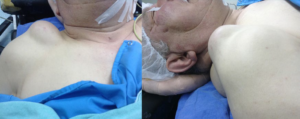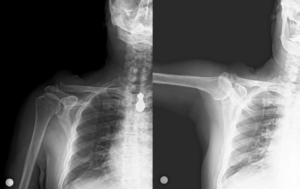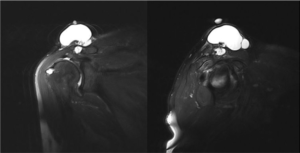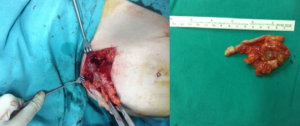1. Montet X, Zamorani-Bianchi MP, Mehdizade A, Martinoli C, Bianchi S. Intramuscular ganglion arising from the acromioclavicular joint. Clin Imaging. 2004; 28(2): 109-112. doi: 10.1016/s0899-7071(03)00104-9
2. Skedros JG, Knight AN. Massive acromioclavicular ganglionic cyst treated with excision and allograft patch of acromioclavicular region. J Shoulder Elbow Surg. 2012; 21(3): 1-5. doi: 10.1016/j.jse.2011.07.033
3. Sarman H, Işık C, Şahin AA, et al. El ve El bilek tümörlü hastalarda eksizyonel biyopsi sonuçlarinin değerlendirilmesi [In Turkish]. Abant Med J. 2014; 3(1): 55-61. doi: 10.5505/abantmedj.2014.30602
4. Orman G, Yesiladali G, Olcay E, Duymus M. Comparison of ultrasonography and magnetic resonance imaging for diagnosis of soft tissue masses of the hand and wrist. Eur J Gen Med. 2015; 12(1): 38-43. doi: 10.15197/sabad.1.12.07
5. Ferrick MR, Marzo JM. Ganglion cyst of the shoulder associated with a glenoid labral tear and symptomatic glenohumeral instability. A case report. Am J Sports Med. 1997; 25(5): 717-719. doi: 10.1177/036354659702500523
6. Good LM, DiCarlo JB, High WA. An unusual cutaneous manifestation of a ganglion cyst. J Am Acad Dermatol. 2011; 64(6): 1206-1208. doi: 10.1016/j.jaad.2009.09.034
7. Parperis K, Carrera G, Baynes K, et al. The prevalence of chondrocalcinosis (CC) of the acromioclavicular (AC) joint on chest radiographs and correlation with calcium pyrophosphate dihydrate (CPPD) crystal deposition disease. Clin Rheumatol. 2013; 32(9): 1383-1386. doi: 10.1007/s10067-013-2255-x
8. Genta MS, Gabay C. Images in clinical medicine. Milwaukee shoulder. N Engl J Med. 2006; 354(2): e2. doi: 10.1056/NEJMicm050094
9. Matev B, Georgiev GP, Stokov L. A rare case of intraosseous ganglion of the triquetrum. J Clin Exp Invest. 2012; 3(1): 111-112. doi: 10.5799/ahinjs.01.2012.01.0124
10. Haber LH, Waanders NA, Thompson GH, Petersilge C, Ballock RT. Sternoclavicular joint ganglion cysts in young children. J Pediatr Orthop. 2002; 22(4): 544-547. Website. http://journals.lww.com/pedorthopaedics/Abstract/2002/07000/Sternoclavicular_Joint_Ganglion_Cysts_In_Young.24.aspx. Accessed
August 10, 2016
11. Deutsch A, Altchek DW, Veltri DM, Potter HG, Warren RF. Traumatic tears of the subscapularis tendon. Clinical diagnosis, magnetic resonance imaging findings, and operative treatment. Am J Sports Med. 1997; 25(1): 13-22. doi: 10.1177/036354659702500104
12. Kessler MA, Stoffel K, Oswald A, Stutz G, Gaechter A. The SLAP lesion as a reason for glenolabral cysts: A report of five cases and review of the literature. Arch Orthop Trauma Surg. 2007; 127(4): 287-292. doi: 10.1007/s00402-006-0154-1
13. Tirman PF, Feller JF, Janzen DL, Peterfy CG, Bergman AG. Association of glenoid labral cysts with labral tears and glenohumeral instability: Radiologic findings and clinical significance. Radiology. 1994; 190(3): 653-658. doi: 10.1148/radiology.190.3.8115605
14. Westerheide KJ, Dopirak RM, Karzel RP, Snyder SJ. Suprascapular nerve palsy secondary to spinoglenoid cysts: Results of arthroscopic treatment. Arthroscopy. 2006; 22(7): 721-727. doi: 10.1016/j.arthro.2006.03.019
15. Schroder CP, Skare O, Stiris M, Gjengedal E, Uppheim G, Brox JI. Treatment of labral tears with associated spinoglenoid cysts without cyst decompression. J Bone Joint Surg Am. 2008; 90(3): 523-530. doi: 10.2106/jbjs.f.01534
16. Youm T, Matthews PV, El Attrache NS. Treatment of patients with spinoglenoid cysts associated with superior labral tears without cyst aspiration, debridement, or excision. Arthroscopy. 2006; 22(5): 548-552. doi: 10.1016/j.arthro.2005.12.060
17. Tung GA, Entzian D, Stern JB, Green A. MR imaging and MR arthrography of paraglenoid labral cysts. AJR Am J Roentgenol. 2000; 174(6): 1707-1715. doi: 10.2214/ajr.174.6.1741707
18. Satku K, Ganesh B. Ganglia in children. J Pediatr Orthop. 1985; 5(1): 13-15. doi: 10.1097/01241398-198501000-00003









